Source Apportionment and Health Risk Assessment of Metal Elements in PM2.5 in Central Liaoning’s Urban Agglomeration
Abstract
1. Introduction
2. Materials and Methods
2.1. Sampling Method
2.2. Chemical Analysis
2.3. PMF Model
2.4. Health Risk Assessment
3. Results and Discussion
3.1. General Element Concentrations in PM2.5
3.2. Element Composition
3.3. Source Identification
3.4. Health Risk Assessment
3.4.1. Non-Carcinogenic Risks
3.4.2. Carcinogenic Risks
4. Conclusions
Supplementary Materials
Author Contributions
Funding
Institutional Review Board Statement
Informed Consent Statement
Data Availability Statement
Acknowledgments
Conflicts of Interest
References
- Yang, G.; Wang, Y.; Zeng, Y.; Gao, G.F.; Liang, X.; Zhou, M.; Wan, X.; Yu, S.; Jiang, Y.; Naghavi, M.; et al. Rapid health transition in China, 1990–2010: Findings from the Global Burden of Disease Study 2010. Lancet 2013, 381, 1987–2015. [Google Scholar] [CrossRef]
- Lim, S.S.; Vos, T.; Flaxman, A.D.; Danaei, G.; Shibuya, K.; Adair-Rohani, H.; AlMazroa, M.A.; Amann, M.; Anderson, H.R.; Andrews, K.G.; et al. A comparative risk assessment of burden of disease and injury attributable to 67 risk factors and risk factor clusters in 21 regions, 1990–2010: A systematic analysis for the Global Burden of Disease Study 2010. Lancet 2012, 380, 2224–2260. [Google Scholar] [CrossRef]
- Duan, X.; Yan, Y.; Li, R.; Deng, M.; Hu, D.; Peng, L. Seasonal variations, source apportionment, and health risk assessment of trace metals in PM2.5 in the typical industrial city of changzhi, China. Atmos. Pollut. Res. 2021, 12, 365–374. [Google Scholar]
- Wang, X.; He, S.; Chen, S.; Zhang, Y.; Wang, A.; Luo, J.; Ye, X.; Mo, Z.; Wu, L.; Xu, P.; et al. Spatiotemporal characteristics and health risk assessment of heavy metals in PM2.5 in Zhejiang province. Int. J. Environ. Res. Pub. Heal. 2018, 15, 583. [Google Scholar] [CrossRef]
- Bellinger, D.C. Teratogen Update: Lead and Pregnancy. Birth Defects Res. A 2005, 73, 409–420. [Google Scholar] [CrossRef]
- Bell, M.L.; Belanger, K.; Ebisu, K.; Gent, J.F.; Lee, H.J.; Koutrakis, P.; Leaderer, B.P. Prenatal exposure to fine particulate matter and birth weight: Variations by particulate constituents and sources. Epidemiology 2010, 21, 884–891. [Google Scholar] [CrossRef] [PubMed]
- Soukup, D.; Buck, B.; Goossens, D.; Ulery, A.; McLaurin, B.T.; Baron, D.; Teng, Y. Arsenic concentrations in dust emissions from wind erosion and off-road vehicles in the Nellis Dunes Recreational Area, Nevada, USA. Aeolian Res. 2012, 5, 77–89. [Google Scholar] [CrossRef]
- Bullock, K.R.; Duvall, R.M.; Norris, G.A.; McDow, S.R.; Hays, M.D. Evaluation of the CMB and PMF models using organic molecular markers in fine particulate matter collected during the Pittsburgh Air Quality Study. Atmos. Environ. 2008, 42, 6897–6904. [Google Scholar] [CrossRef]
- Shi, G.; Zeng, F.; Li, X.; Feng, Y.; Wang, Y.; Liu, G.; Zhu, T. Estimated contributions and uncertainties of PCA/MLR–CMB results: Source apportionment for synthetic and ambient datasets. Atmos. Environ. 2011, 45, 2811–2819. [Google Scholar] [CrossRef]
- Hopke, P.K. Review of receptor modeling methods for source apportionment. J. Air Waste Manag. 2016, 66, 237–259. [Google Scholar] [CrossRef] [PubMed]
- Paatero, P. Least squares formulation of robust non-negative factor analysis. Chemometr. Intell. Lab. 1997, 37, 23–35. [Google Scholar] [CrossRef]
- Wang, F.; Guo, Z.; Lin, T.; Rose, N.L. Seasonal variation of carbonaceous pollutants in PM2.5 at an urban ‘supersite’ in Shanghai, China. Chemosphere 2016, 146, 238–244. [Google Scholar] [PubMed]
- Zhao, S.; Tian, H.; Luo, L.; Liu, H.; Wu, B.; Liu, S.; Bai, X.; Liu, W.; Liu, X.; Wu, Y.; et al. Temporal variation characteristics and source apportionment of metal elements in PM2.5 in urban Beijing during 2018–2019. Environ. Pollut. 2021, 268, 115856. [Google Scholar] [CrossRef] [PubMed]
- Yao, L.; Yang, L.; Yuan, Q.; Yan, C.; Dong, C.; Meng, C.; Sui, X.; Yang, F.; Lu, Y.; Wang, W. Sources apportionment of PM2.5 in a background site in the North China Plain. Sci. Total Environ. 2016, 541, 590–598. [Google Scholar] [CrossRef] [PubMed]
- Gao, Y.; Ji, H. Microscopic morphology and seasonal variation of health effect arising from heavy metals in PM2.5 and PM10: One-year measurement in a densely populated area of urban Beijing. Atmos. Res. 2018, 212, 213–226. [Google Scholar] [CrossRef]
- Mateos, A.C.; Amarillo, A.C.; Carreras, H.A.; Gonzalez, C.M. Land use and air quality in urban environments: Human health risk assessment due to inhalation of airborne particles. Environ. Res. 2018, 161, 370–380. [Google Scholar] [CrossRef]
- Peng, X.; Shi, G.; Liu, G.; Xu, J.; Tian, Y.; Zhang, Y.; Feng, Y.; Russell, A.G. Source apportionment and heavy metal health risk (HMHR) quantification from sources in a southern city in China, using an ME2-HMHR model. Environ. Pollut. 2017, 221, 335–342. [Google Scholar] [CrossRef]
- Shi, Y.; Bilal, M.; Ho, H.C.; Omar, A. Urbanization and regional air pollution across South Asian developing countries—A nationwide land use regression for ambient PM2.5 assessment in Pakistan. Environ. Pollut. 2020, 266, 115145. [Google Scholar] [CrossRef] [PubMed]
- Tao, J.; Zhang, L.; Cao, J.; Zhong, L.; Chen, D.; Yang, Y.; Chen, D.; Chen, L.; Zhang, Z.; Wu, Y.; et al. Source apportionment of PM2.5 at urban and suburban areas of the Pearl River Delta region, South China—With emphasis on ship emissions. Sci. Total Environ. 2017, 574, 1559–1570. [Google Scholar] [CrossRef]
- Xie, J.; Jin, L.; Cui, J.; Luo, X.; Li, J.; Zhang, G.; Li, X. Health risk-oriented source apportionment of PM2.5-associated trace metals. Environ. Pollut. 2020, 262, 114655. [Google Scholar] [CrossRef] [PubMed]
- Song, W.; Jia, H.; Huang, J.; Zhang, Y. A satellite-based geographically weighted regression model for regional PM2.5 estimation over the Pearl River Delta Region in China. Remote Sens. Environ. 2014, 154, 1–7. [Google Scholar] [CrossRef]
- Jiang, L.; He, S.; Zhou, H. Spatio-temporal characteristics and convergence trends of PM2.5 pollution: A case study of cities of air pollution transmission channel in Beijing-Tianjin-Hebei region, China. J. Clean Prod. 2020, 256, 120631. [Google Scholar] [CrossRef]
- Wang, X.; Shen, Z.; Liu, F.; Lu, D.; Tao, J.; Lei, Y.; Zhang, Q.; Zeng, Y.; Xu, H.; Wu, Y.; et al. Saccharides in summer and winter PM2.5 over Xi’an, Northwestern China: Sources, and yearly variations of biomass burning contribution to PM2.5. Atmos. Res. 2018, 214, 410–417. [Google Scholar] [CrossRef]
- Batterman, S.; Xu, L.; Chen, F.; Chen, F.; Zhong, X. Characteristics of PM2.5 concentrations across Beijing during 2013–2015. Atmos. Environ. 2016, 145, 104–114. [Google Scholar] [CrossRef] [PubMed]
- Zhang, F.; Wang, Z.; Cheng, H.; Lv, X.; Gong, W.; Wang, X.; Zhang, G. Seasonal variations and chemical characteristics of PM2.5 in Wuhan, central China. Sci. Total Environ. 2015, 518-519, 97–105. [Google Scholar] [CrossRef]
- Kong, S.; Ding, X.; Bai, Z.; Han, B.; Chen, L.; Shi, J.; Li, Z. A seasonal study of polycyclic aromatic hydrocarbons in PM2.5 and PM2.5-10 in five typical cities of Liaoning Province, China. J. Hazard. Mater. 2010, 183, 70–80. [Google Scholar] [CrossRef]
- Bell, M.L.; Ebisu, K.; Peng, R.D. Community-level spatial heterogeneity of chemical constituent levels of fine particulates and implications for epidemiological research. J. Expo. Sci. Environ. Epid. 2010, 21, 372–384. [Google Scholar] [CrossRef] [PubMed]
- Wang, N.; Zhao, X.; Wang, J.; Yin, B.; Geng, C.; Niu, D.; Yang, W.; Yu, H.; Li, W. Chemical composition of PM2.5 and its impact on inhalation health risk evaluation in a city with light industry in central China. Atmosphere 2020, 11, 340. [Google Scholar] [CrossRef]
- Kong, S.; Han, B.; Bai, Z.; Chen, L.; Shi, J.; Xu, Z. Receptor modeling of PM2.5, PM10 and TSP in different seasons and long-range transport analysis at a coastal site of Tianjin, China. Sci. Total Environ. 2010, 408, 4681–4694. [Google Scholar] [CrossRef]
- Li, H.; Wang, Q.g.; Yang, M.; Li, F.; Wang, J.; Sun, Y.; Wang, C.; Wu, H.; Qian, X. Chemical characterization and source apportionment of PM2.5 aerosols in a megacity of Southeast China. Atmos. Res. 2016, 181, 288–299. [Google Scholar] [CrossRef]
- Manual RAGF. Process for Conducting Probabilistic Risk Assessment; EPA: Washington, DC, USA, 1989. [Google Scholar]
- Zhang, J.; Zhou, X.; Wang, Z.; Yang, L.; Wang, J.; Wang, W. Trace elements in PM2.5 in Shandong Province: Source identification and health risk assessment. Sci. Total Environ. 2018, 621, 558–577. [Google Scholar] [CrossRef]
- US EPA (U.S. Environmental Protection Agency). Risk Assessment Guidance for Superfund Volume I: Human Health Evaluation Manual (Part A). 1989; EPA/540/R/1-89/002. Available online: http://www.epa.gov/swerrims/riskassessment/ragsa/index.htm (accessed on 20 October 2020).
- US EPA (U.S. Environmental Protection Agency). Risk Assessment Guidance for Superfund Volume I: Human Health Evaluation Manual (Part F). 2009; EPA-540-R-070-002. Available online: http://www.epa.gov/swerrims/riskassessment/ragsa/index.htm (accessed on 20 October 2020).
- Agarwal, A.; Mangal, A.; Satsangi, A.; Lakhani, A.; Kumari, K.M. Characterization, sources and health risk analysis of PM2.5 bound metals during foggy and non-foggy days in sub-urban atmosphere of Agra. Atmos. Res. 2017, 197, 121–131. [Google Scholar] [CrossRef]
- Feng, J.; Yu, H.; Su, X.; Liu, S.; Li, Y.; Pan, Y.; Sun, J.-H. Chemical composition and source apportionment of PM2.5 during Chinese Spring Festival at Xinxiang, a heavily polluted city in North China: Fireworks and health risks. Atmos. Res. 2016, 182, 176–188. [Google Scholar] [CrossRef]
- Jain, S.; Sharma, S.K.; Vijayan, N.; Mandal, T.K. Seasonal characteristics of aerosols (PM2.5 and PM10) and their source apportionment using PMF: A four year study over Delhi, India. Environ. Pollut. 2020, 262, 114337. [Google Scholar] [CrossRef]
- Chang, Y.; Huang, K.; Xie, M.; Deng, C.; Zou, Z.; Liu, S.; Zhang, Y. First long-term and near real-time measurement of trace elements in China’s urban atmosphere: Temporal variability, source apportionment and precipitation effect. Atmos. Chem. Phys. 2018, 18, 11793–11812. [Google Scholar] [CrossRef]
- Hao, Y.; Meng, X.; Yu, X.; Lei, M.; Li, W.; Shi, F.; Yang, W.; Zhang, S.; Xie, S. Characteristics of trace elements in PM2.5 and PM10 of Chifeng, Northeast China: Insights into spatiotemporal variations and sources. Atmos. Res. 2018, 213, 550–561. [Google Scholar] [CrossRef]
- Han, Y.; Kim, H.; Cho, S.; Kim, P.; Kim, W. Metallic elements in PM2.5 in different functional areas of Korea: Concentrations and source identification. Atmos. Res. 2015, 153, 416–428. [Google Scholar] [CrossRef]
- Li, X.; Ma, Y.; Wang, Y.; Liu, N.; Hong, Y. Temporal and spatial analyses of particulate matter (PM10 and PM2.5) and its relationship with meteorological parameters over an urban city in Northeast China. Atmos. Res. 2017, 198, 185–193. [Google Scholar] [CrossRef]
- Anshan Bureau Statistics. Analysis on the Development Status of Magnesite Clinker Industry in Anshan. 2020. Available online: http://tjj.anshan.gov.cn/html/TJJ/202012/0160707312168743.html (accessed on 20 January 2021).
- Yingkou Bureau Statistics Statistical Bulletins 2018 of Yingkou. 2019. Available online: http://tjj.yingkou.gov.cn/008/008002/20190515/528478a0-e80f-49f1-b293-89befc75271e.html (accessed on 20 October 2020).
- Zhang, R.; Jing, J.; Tao, J.; Hsu, S.C.; Wang, G.; Cao, J.; Lee, C.S.L.; Zhu, L.; Chen, Z.; Zhao, Y. Chemical characterization and source apportionment of PM2.5 in Beijing: Seasonal perspective. Atmos. Chem. Phys. 2013, 13, 9953–10007. [Google Scholar] [CrossRef]
- Mokhtar, M.M.; Taib, R.M.; Hassim, M.H. Understanding selected trace elements behavior in a coal-fired power plant in Malaysia for assessment of abatement technologies. J. Air Waste Manag. 2014, 64, 867–878. [Google Scholar] [CrossRef]
- Hsu, C.Y.; Chiang, H.C.; Lin, S.L.; Chen, M.J.; Lin, T.Y.; Chen, Y.C. Elemental characterization and source apportionment of PM10 and PM2.5 in the western coastal area of central Taiwan. Sci. Total. Environ. 2016, 541, 1139–1150. [Google Scholar] [CrossRef] [PubMed]
- Zhou, S.; Yuan, Q.; Li, W.; Lu, Y.; Zhang, Y.; Wang, W. Trace metals in atmospheric fine particles in one industrial urban city: Spatial variations, sources, and health implications. J. Environ. Sci. 2014, 26, 205–213. [Google Scholar] [CrossRef]
- Liu, J.; Chen, Y.; Chao, S.; Cao, H.; Zhang, A.; Yang, Y. Emission control priority of PM2.5-bound heavy metals in different seasons: A comprehensive analysis from health risk perspective. Sci. Total Environ. 2018, 644, 20–30. [Google Scholar] [CrossRef]
- Xu, C.; Guan, Q.; Lin, J.; Luo, H.; Yang, L.; Tan, Z.; Wang, Q.; Wang, N.; Tian, J. Spatiotemporal variations and driving factors of dust storm events in Northern China based on high-temporal-resolution analysis of meteorological data (1960–2007). Environ. Pollut. 2020, 260, 114084. [Google Scholar] [CrossRef] [PubMed]
- Sofowote, U.M.; Di Federico, L.M.; Healy, R.M.; Debosz, J.; Su, Y.; Wang, J.; Munoz, A. Heavy metals in the near-road environment: Results of semi-continuous monitoring of ambient particulate matter in the greater Toronto and Hamilton area. Atmos. Environ. 2019, 1, 100005. [Google Scholar] [CrossRef]
- Thorpe, A.; Harrison, R.M. Sources and properties of non-exhaust particulate matter from road traffic: A review. Sci. Total Environ. 2008, 400, 270–282. [Google Scholar] [CrossRef] [PubMed]
- Li, F.; Yan, J.; Wei, Y.; Zeng, J.; Wang, X.; Chen, X.; Zhang, C.; Li, W.; Chen, M.; Lü, G. PM2.5-bound heavy metals from the major cities in China: Spatiotemporal distribution, fuzzy exposure assessment and health risk management. J. Clean Prod. 2021, 286, 124967. [Google Scholar] [CrossRef]

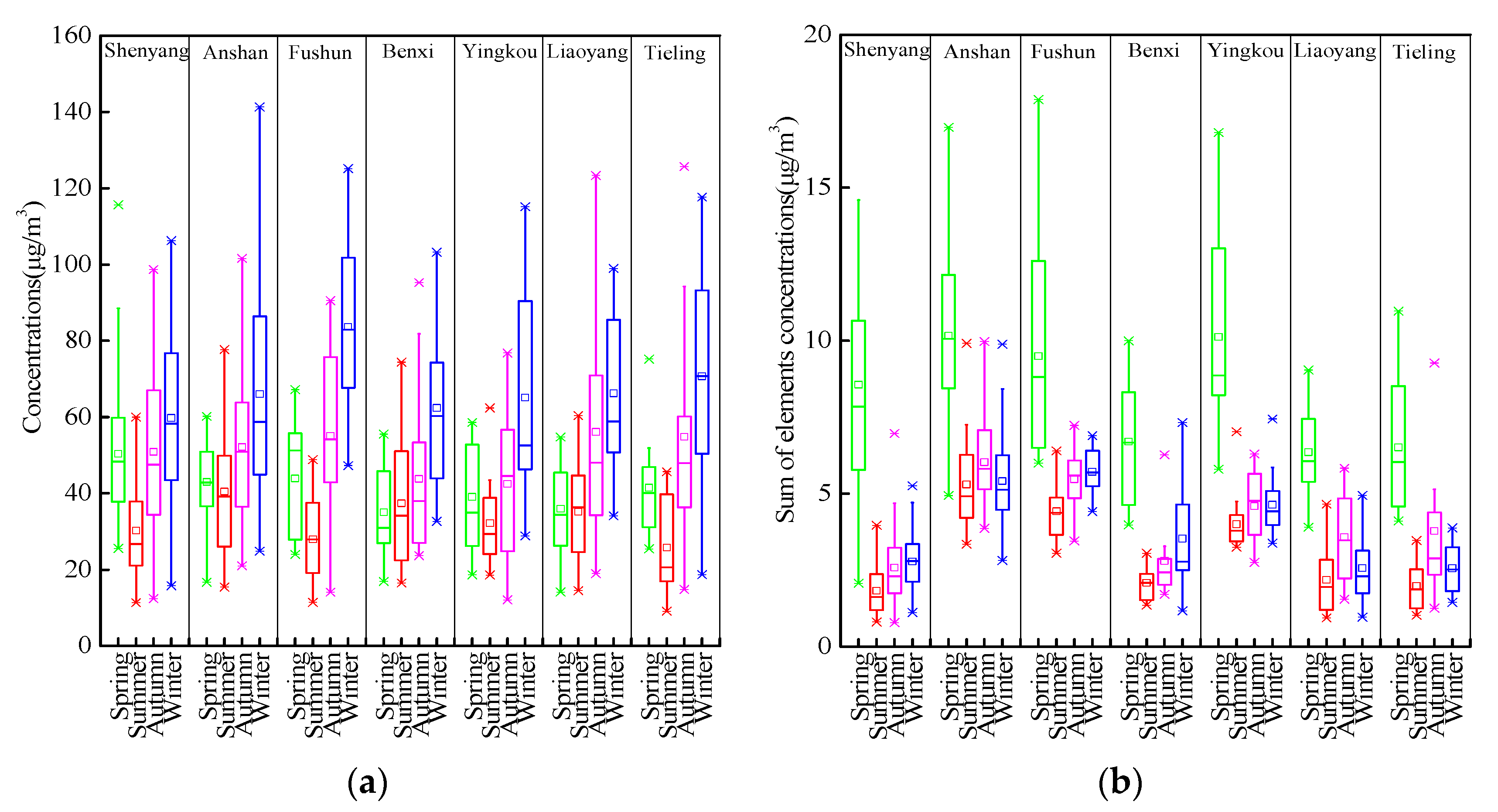
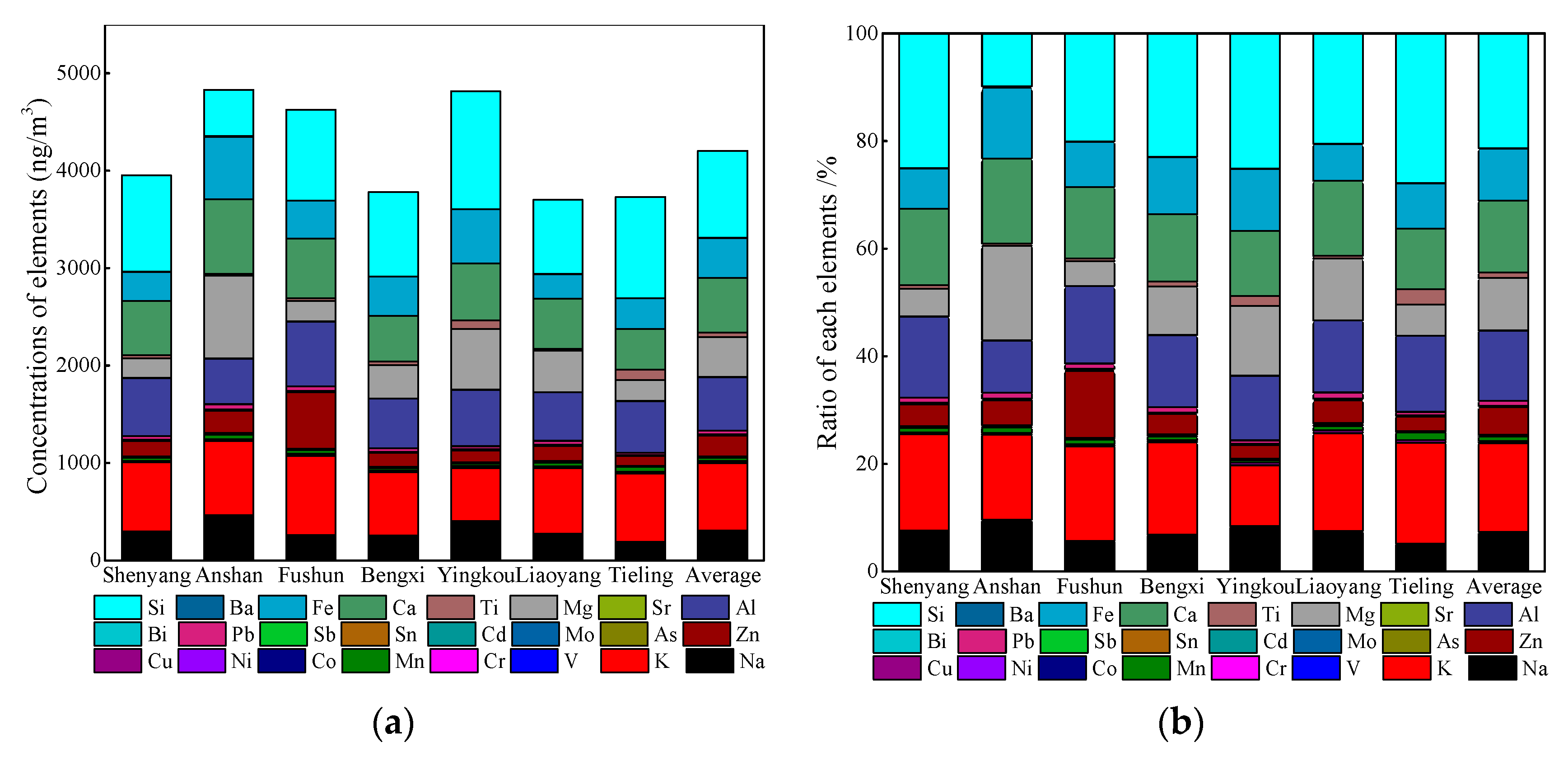
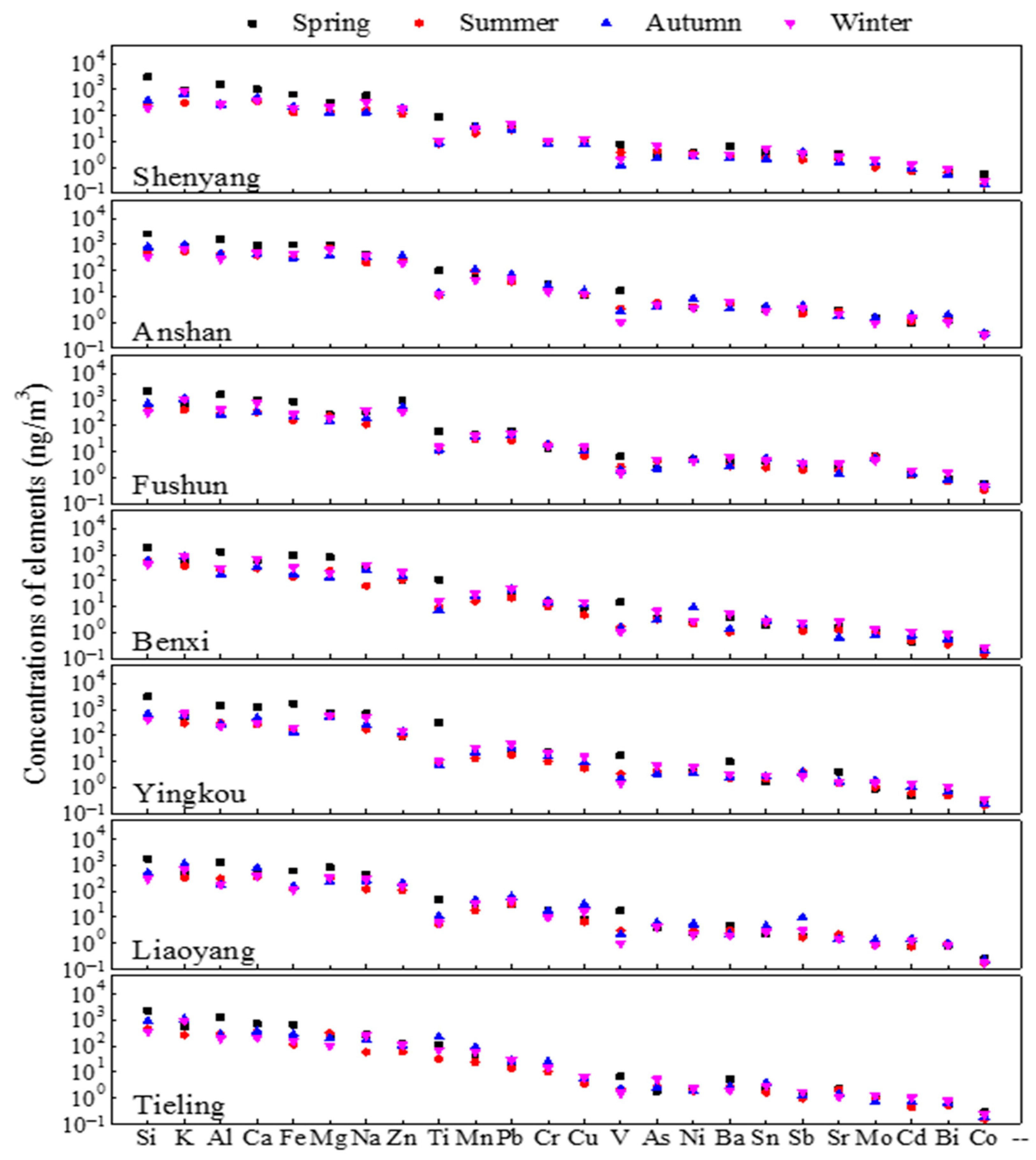
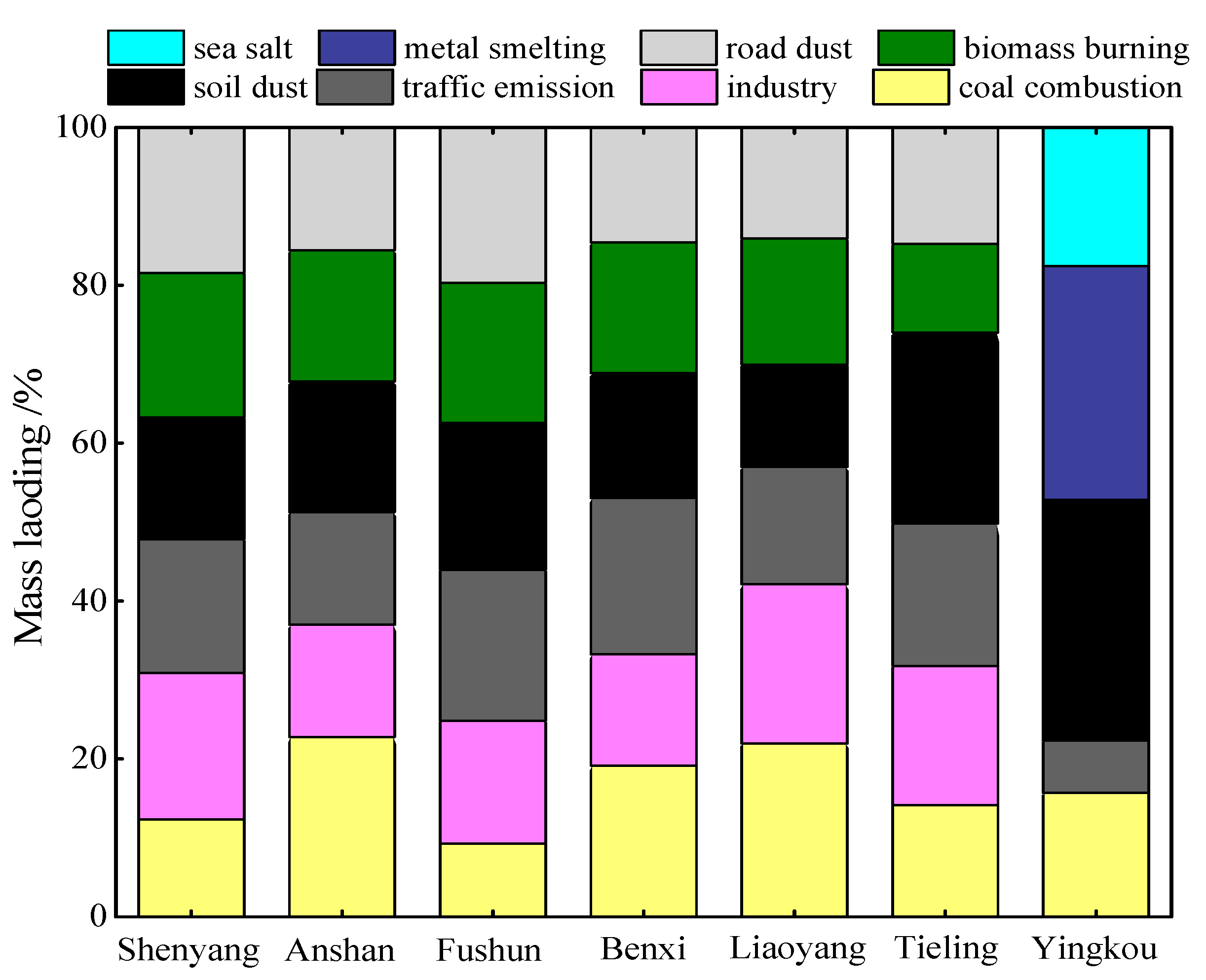
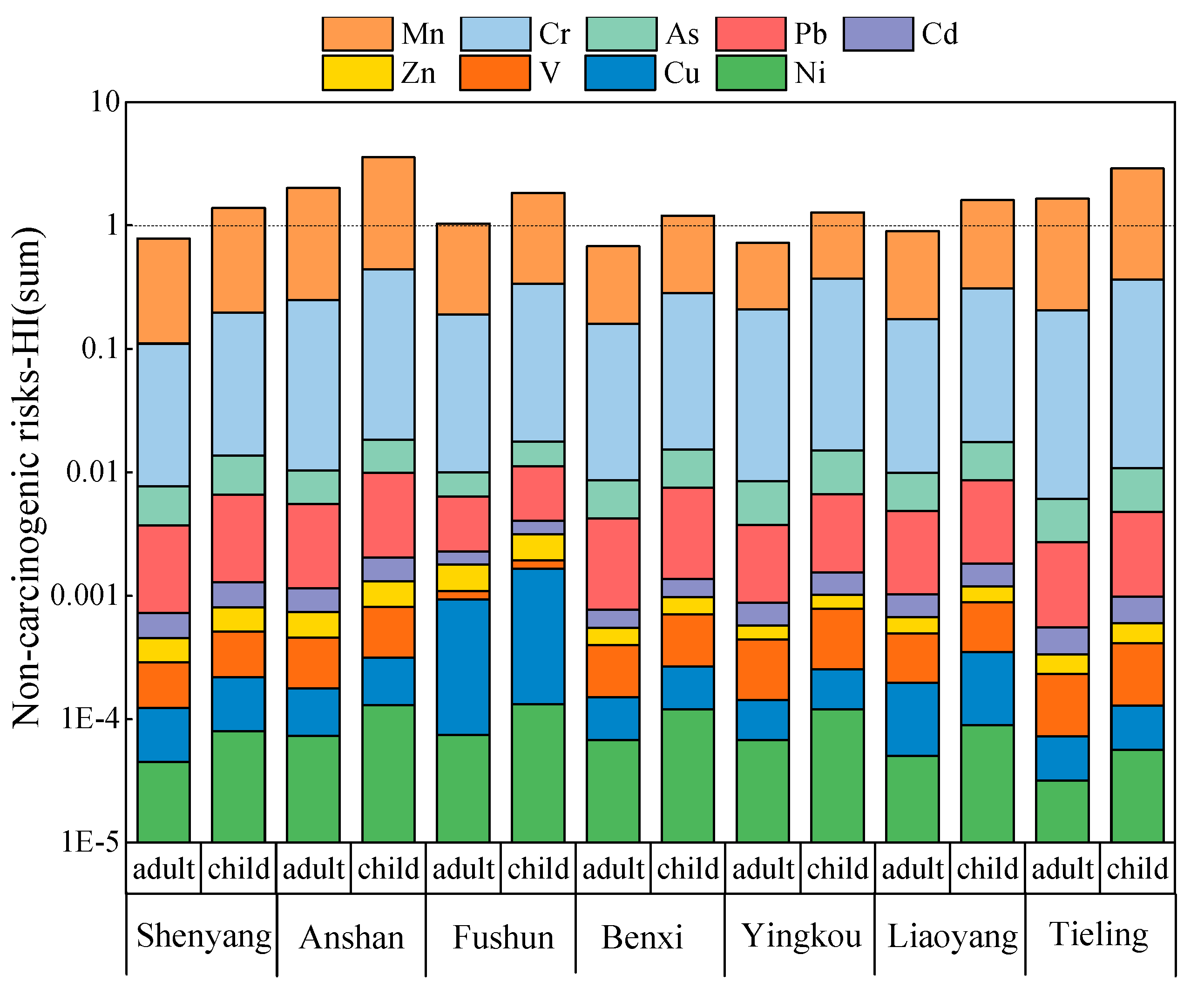
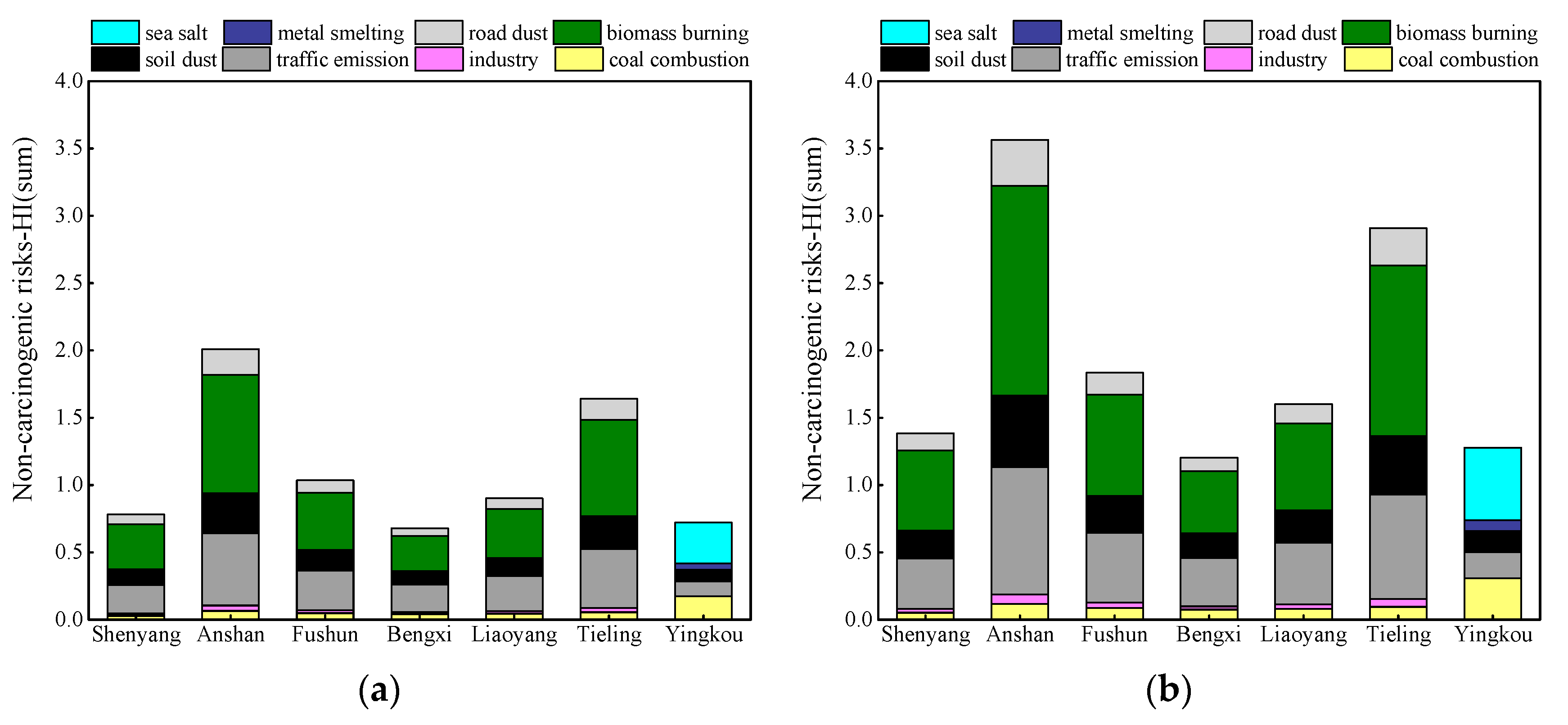
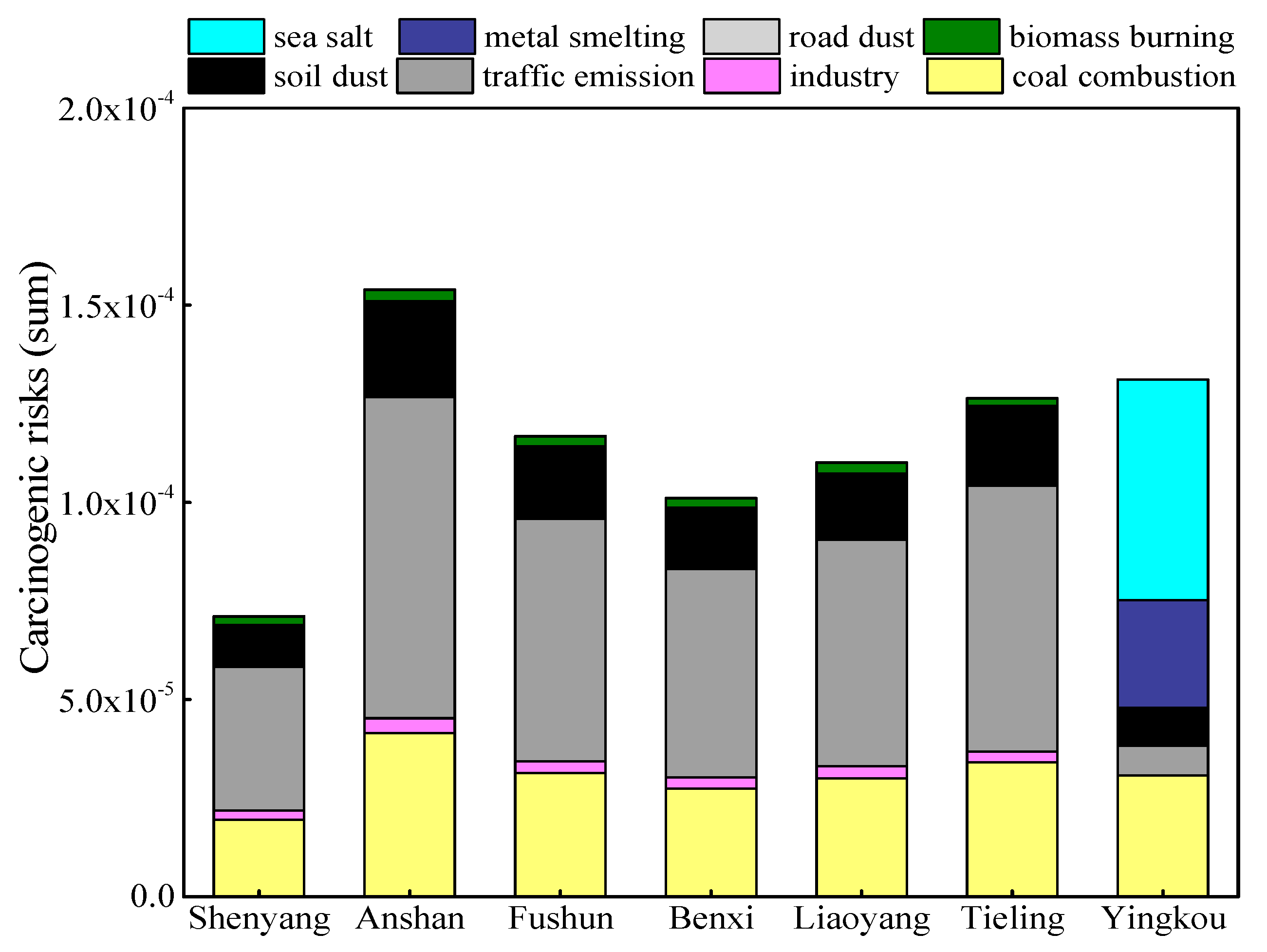
| Species | Shenyang | Anshan | Funshun | Bengxi | Yingkou | Liaoyang | Tieling |
|---|---|---|---|---|---|---|---|
| Cr | 6.09 × 10−5 | 1.41 × 10−4 | 1.06 × 10−4 | 9.00 × 10−5 | 1.19 × 10−4 | 9.74 × 10−5 | 1.18 × 10−4 |
| Ni | 3.87 × 10−7 | 6.26 × 10−7 | 6.38 × 10−7 | 5.81 × 10−7 | 5.81 × 10−7 | 4.33 × 10−7 | 2.73 × 10−7 |
| As | 9.01 × 10−6 | 1.09 × 10−5 | 8.19 × 10−6 | 9.83 × 10−6 | 1.06 × 10−5 | 1.13 × 10−5 | 7.57 × 10−6 |
| Cd | 8.54 × 10−7 | 1.28 × 10−6 | 1.54 × 10−6 | 6.83 × 10−7 | 9.40 × 10−7 | 1.11 × 10−6 | 6.83 × 10−7 |
Publisher’s Note: MDPI stays neutral with regard to jurisdictional claims in published maps and institutional affiliations. |
© 2021 by the authors. Licensee MDPI, Basel, Switzerland. This article is an open access article distributed under the terms and conditions of the Creative Commons Attribution (CC BY) license (https://creativecommons.org/licenses/by/4.0/).
Share and Cite
Guo, Q.; Li, L.; Zhao, X.; Yin, B.; Liu, Y.; Wang, X.; Yang, W.; Geng, C.; Wang, X.; Bai, Z. Source Apportionment and Health Risk Assessment of Metal Elements in PM2.5 in Central Liaoning’s Urban Agglomeration. Atmosphere 2021, 12, 667. https://doi.org/10.3390/atmos12060667
Guo Q, Li L, Zhao X, Yin B, Liu Y, Wang X, Yang W, Geng C, Wang X, Bai Z. Source Apportionment and Health Risk Assessment of Metal Elements in PM2.5 in Central Liaoning’s Urban Agglomeration. Atmosphere. 2021; 12(6):667. https://doi.org/10.3390/atmos12060667
Chicago/Turabian StyleGuo, Qingyuan, Liming Li, Xueyan Zhao, Baohui Yin, Yingying Liu, Xiaoli Wang, Wen Yang, Chunmei Geng, Xinhua Wang, and Zhipeng Bai. 2021. "Source Apportionment and Health Risk Assessment of Metal Elements in PM2.5 in Central Liaoning’s Urban Agglomeration" Atmosphere 12, no. 6: 667. https://doi.org/10.3390/atmos12060667
APA StyleGuo, Q., Li, L., Zhao, X., Yin, B., Liu, Y., Wang, X., Yang, W., Geng, C., Wang, X., & Bai, Z. (2021). Source Apportionment and Health Risk Assessment of Metal Elements in PM2.5 in Central Liaoning’s Urban Agglomeration. Atmosphere, 12(6), 667. https://doi.org/10.3390/atmos12060667






